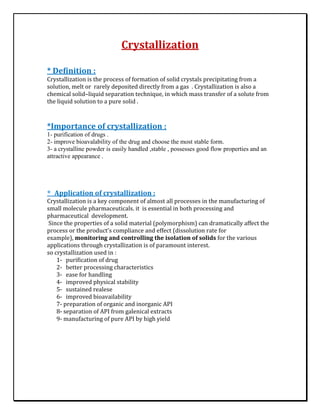Crystallization 3
- 1. Crystallization * Definition : Crystallization is the process of formation of solid crystals precipitating from a solution, melt or rarely deposited directly from a gas . Crystallization is also a chemical solidâliquid separation technique, in which mass transfer of a solute from the liquid solution to a pure solid . *Importance of crystallization : 1- purification of drugs . 2- improve bioavalability of the drug and choose the most stable form. 3- a crystalline powder is easily handled ,stable , possesses good flow properties and an attractive appearance . * Application of crystallization : Crystallization is a key component of almost all processes in the manufacturing of small molecule pharmaceuticals. it is essential in both processing and pharmaceutical development. Since the properties of a solid material (polymorphism) can dramatically affect the process or the productâs compliance and effect (dissolution rate for example), monitoring and controlling the isolation of solids for the various applications through crystallization is of paramount interest. so crystallization used in : 1- purification of drug 2- better processing characteristics 3- ease for handling 4- improved physical stability 5- sustained realese 6- improved bioavailability 7- preparation of organic and inorganic API 8- separation of API from galenical extracts 9- manufacturing of pure API by high yield
- 2. * Theory of crystallization : The three major stages in the process of Crystallization are- 1. Super saturation of the solution : It can be done by three ways. Heating the solution Cooling the solution Salting out 2.Nucleation : This takes place in several steps. During their random motion, the atoms/ molecules/ ions will come closer to one another and forms aggregates called as CLUSTERS. These clusters will combine to form an EMBRYO. In this stage only the lattice formation begins. This embryoâs combine to form NUCLEI. From nuclei crystals are formed 3.Crystal Growth : Once the crystals are formed, nuclei formation stops and crystal growth begins.
- 3. *Crystallization crystallizers : Draft tube baffle technology: This type of crystallization is especially designed for low viscosity products when a narrow crystal size distribution is expected. Super saturated product enters into a chamber containing the massecuite (mixture of solids and solution). Instantaneously, the product crystallizes around the crystals that are already inside the vessel so that the solution reaches the saturation point. Inside the chamber, a stirrer creates a high circulation flow in order to give a good repartition of the crystals in the massecuite. On the side of the vessel, baffles create a quiet zone where an upward flow brings the smallest crystals out of the vessels. They are re-melted and put back in the vessel. Forced circulation crystallization: The design of such a crystallization unit is very similar to a forced circulation evaporator. A vertical tubular heat exchanger is only preferred due to the high viscosity of the massecuite. This type of crystallization unit is designed for the crystallization of salts out of effluent.




